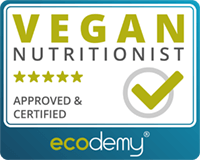Intake Of Necessary Minerals
On how to increase the bioavailability of micronutrients while eating plant-based — Insight of a certified vegan nutrition coach

Visit activeplantbased for professional help and plant-based nutrition training.
This article is for you if…
- You’re an athlete who wants to eat entirely plant-based but is an omnivore.
- You want to know how to increase mineral absorption.
- You want to know what minerals you need to pay attention to.
- You’re a regular dude who needs information about minerals.
Key points
- When we talk about macronutrients or micronutrients, we talk about the amount needed to satisfy our physical needs.
- We need less than 100 milligrams of micronutrients per day, whereas we need macronutrient quantities measured in grams per day.
- Micronutrients include minerals, trace elements and vitamins.
- Macronutrients include carbohydrates, proteins, fats, water, dietary fibre (and alcohol).
- Your body’s need for nutrients does not change based on the diet; however, following a plant-based diet, you will need to consume larger amounts.
- The consumed amount increases because of various factors, such as bioavailability, concentration in plants, and other substances that may interfere.
- All minerals originate from the soil, not from animals.
- Minerals provide energy and assist muscles and the nervous system.
- Nutrients particularly relevant to vegans are Zinc, Calcium, Iron and Magnesium.
- Phytates and tannins are anti-nutritive substances best not to be consumed in combination with mineral-rich foods.
- Increase your mineral absorption by soaking, sprouting, cooking, fermenting, and combining with organic acids such as in fruits and pickled vegetables.
People often express their concerns about athletes in relation to plant-based micronutrients. What about iron and calcium? — Yes, you can cover all those things, and it’s not complicated. You need to know what to pay attention to.
Micronutrients? Macronutrients?
Micro- and macro- are prefixes that people like to mix up.
Micro comes from the greek word mikrós which means small. Macro is the opposite and means of great size or large.
I think of the i-dot on the micro as something as small as a dot, which helped me separate those two words.
Now you know what a microwave does (it has to do something with small waves). A microscope helps look at small things. Now we can remember these two prefixes very conveniently.
Please note that in our case, when we talk about macronutrients or micronutrients, we don’t mean the actual size of the nutrient but the amount needed to satisfy our physical needs.
Micronutrient vs macronutrient intake
Generally, we need less than 100 milligrams of micronutrients per day, whereas we need macronutrient quantities measured in grams per day.
Micronutrients (nutrients needed in small quantities) are
minerals, trace elements and vitamins.
Minerals, such as
- Calcium
- Sulphur
- Phosphorus
- Magnesium
- Sodium
- Potassium
- Iron
- Zinc
Trace elements (nutrients needed in minimal quantities), such as
- Boron
- Copper
- Chromium (depends on who you ask)
- Selenium
- Manganese
- Molybdenum
- Cobalt (Vitamin B12 compound)
- Fluoride
- Iodine
All vitamins and carotenoids, such as
- Vitamins A, B, C, D, E, K
- Choline
- Carotenoids

Because this article is about minerals, I will not go in-depth about the macronutrients or vitamins yet.
But for the sake of completion: Macronutrients are
- Carbohydrates (you know these as “sugars”)
- Proteins (or amino acids)
- Fats (saturated and unsaturated)
- Water (does not provide energy, but is essential for life)
- Dietary fibre (provides little energy but has other health benefits)
- Alcohol (provides energy but is not essential for life, you can put your drink down)
Bodily needs of omnivores vs plant eaters
I want you to imagine the following scenario: Let’s say we have a person called Alex and his clone named Theo. Imagine that Theo is Alex’ 1:1 copy, and everything down to the last cell regulation is the same. Now let’s assume that Alex follows an omnivore diet, while Theo decided to eat entirely plant-based from tomorrow onwards.
Theo will not develop a higher need for any nutrient overnight
Physiologically speaking, Theo’s requirements for all nutrients stay the same as before and are the exact needs Alex also has — but Theo may need to consume more total nutrients from plant sources to get the same results.
Theo needs to consume more total nutrients from a plant source
Why is that? After all, we established that Theo does not have a higher bodily need! — It’s because of various factors, such as the availability to absorb from plants (bioavailability), lower total concentrations in plants generally, or even anti-nutritive substances in plants.
Again, Theo’s nutritional demands do not increase just because he decides to stop eating meat. The diet alone cannot determine higher or lower nutrient needs within the same body.
Plant-based sources are considered to be the lesser quality of micronutrient sources because
- The bioavailability (the ability of the human body to absorb a nutrient from a plant) might be lower, meaning we need to get in more total nutrients to cover our needs.
- The total nutrient concentration within one plant source might be lower.
- The foods on your plate could contain anti-nutritive substances
In life, people are individuals, and our needs vary. Various factors affect our nutrient intake needs, depending on our gender, age, activity levels, health, pregnancy status etc.
Luckily, a diet including unprocessed plant-based whole foods is high in total micronutrients over a day, so we don’t need to worry about every micronutrient out there.
Now we know that plant-based foods, factually, contain micronutrients in lower quantities than animal-derived foods, and some plant-derived micronutrients might be absorbed less by the human body than the animal-derived version.
However, that fact has no significance as long as we can cover our micronutrient needs. That means we must eat more of those tasty plant-based foods while hitting our daily calorie goals.
Plant sources also win in other areas, being generally healthier and high sources of dietary fibre, phytochemicals and various micronutrients.

All minerals originate from the soil, not from animals
We can receive micronutrients by eating animals, which use plant sources to stock up on their mineral needs. No animal can produce minerals.
If you’re consuming animal products solely for your mineral intake, it would make more sense to skip that animal on your plate, as Theo did, and return to the source.
Function of minerals
Minerals are crucial for keeping our nervous system and muscles functioning properly and are usually the main concern regarding vegan dieting. They also play a significant role in energising your body.
For your body to absorb the largest amount of micronutrients possible and to meet its needs, it is best to consume unprocessed foods at a higher rate than processed/highly processed foods.
You can increase mineral absorption by soaking, sprouting, cooking, fermenting, and combining with organic acids such as in fruits and pickled vegetables.
Increase mineral absorption
Paying attention to food combinations and preparation methods can help increase absorption, also known as bioavailability.
Here is a list of nutrients particularly relevant to vegans and vegan athletes:
1. Zinc
Good zinc plant resources are
- whole grains and pseudo-cereals (oats, rice, wild rice, quinoa, chia seeds, buckwheat, corn etc.)
- legumes (beans, peas, lentils)
- sesame seeds, pumpkin seeds
- maitake mushrooms, porcini mushrooms
Soaking beans, grains, nuts and seeds before consuming and combining them with fruits or pickled vegetables will increase bioavailability through organic acidity.
2. Calcium
Calcium is essential for keeping bones healthy and strong! A deficiency can lead to a high risk of bone fracture.
A list of plant foods high in calcium
- Green vegetables (broccoli, kale)
- Sesame seeds or tahini
- Poppy seeds
- Tofu
- Almonds (almond milk/yoghurt)
- Figs
Again, it’s recommended to soak, cook, ferment or combine with fruits or pickled vegetables to increase calcium bioavailability.
3. Iron
Iron greatly assists the immune system and the body in providing enough energy for good athletic performance.
Foods rich in iron include
- nuts
- whole grains
- legumes
- dates
- green leafy veggies
- miso and soy (both soy products)
These are best combined with vitamin C-rich foods such as oranges, peppers and kiwi. Iron-containing meals are best to eat as far away from training as possible.
4. Magnesium
Magnesium is essential for muscle recovery and reconstruction, bone formation and energy levels. It has been observed that a daily supplement of about 400mgs can have a positive impact on a person’s strength and endurance.
Magnesium-rich foods are
- whole grains
- legumes
- nuts
- shiitake mushrooms
- sunflower seeds
- mineral water with gas
Again, soak, sprout or ferment to increase magnesium bioavailability.
Anti-nutritive substances
- Phytates
Phytates can be found naturally in cereal and legumes and are considered anti-nutritive substances, but that does not mean that they’re generally unhealthy. They can have positive effects on our bodies.
To increase mineral absorption, phytates need to be reduced through soaking, fermenting, cooking or sprouting. That will naturally increase the bioavailability of the minerals through decreasing the effect of phytates.
- Tannins
Tannins are naturally occurring in black tea and coffee. Again, that does not mean we should avoid tea and coffee, but tannins disturb iron and calcium bioavailability.
Separate the intake of mineral-rich food sources and anti-nutritive sources from each other or decrease their amounts naturally by soaking, fermenting, sprouting, and combining with organic acids such as in fruits or pickled vegetables.

